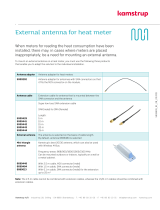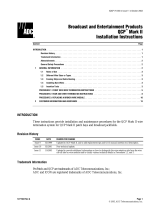ADC Digivance ICS 800 Installation Instructions Manual
- Category
- Network antennas
- Type
- Installation Instructions Manual
This manual is also suitable for
ADC Digivance ICS 800 is a versatile indoor coverage solution designed to extend cellular coverage and improve signal quality in various environments. With its compact size and user-friendly design, it's ideal for enhancing connectivity in offices, hospitals, hotels, and other indoor spaces. The system operates on either 800 or 1900 MHz frequency bands, providing reliable coverage for a wide range of cellular devices.
ADC Digivance ICS 800 is a versatile indoor coverage solution designed to extend cellular coverage and improve signal quality in various environments. With its compact size and user-friendly design, it's ideal for enhancing connectivity in offices, hospitals, hotels, and other indoor spaces. The system operates on either 800 or 1900 MHz frequency bands, providing reliable coverage for a wide range of cellular devices.




















-
 1
1
-
 2
2
-
 3
3
-
 4
4
-
 5
5
-
 6
6
-
 7
7
-
 8
8
-
 9
9
-
 10
10
-
 11
11
-
 12
12
-
 13
13
-
 14
14
-
 15
15
-
 16
16
-
 17
17
-
 18
18
-
 19
19
-
 20
20
-
 21
21
-
 22
22
ADC Digivance ICS 800 Installation Instructions Manual
- Category
- Network antennas
- Type
- Installation Instructions Manual
- This manual is also suitable for
ADC Digivance ICS 800 is a versatile indoor coverage solution designed to extend cellular coverage and improve signal quality in various environments. With its compact size and user-friendly design, it's ideal for enhancing connectivity in offices, hospitals, hotels, and other indoor spaces. The system operates on either 800 or 1900 MHz frequency bands, providing reliable coverage for a wide range of cellular devices.
Ask a question and I''ll find the answer in the document
Finding information in a document is now easier with AI
Related papers
-
ADC Telecommunications F8I-DVICS1900-1 User manual
-
ADC Telecommunications Digivance User manual
-
ADC Telecommunications F8I-DVICSRIU1900 User manual
-
ADC InterReach 1900 PCS User manual
-
ADC ADCP-75-237 Quick start guide
-
ADC Telecommunications F8I-DVICSRIU800 User manual
-
ADC Digivance Operating instructions
-
ADC 11896-B User manual
-
ADC Network Router NXD User manual
-
ADC RF Worx RDS-2 User manual
Other documents
-
OvisLink WAI-070-R Datasheet
-
MI ALMA B5-4×4 Peel and Stick Backsplash Tile Installation guide
-
 MOUNTDOG 5823853011 User guide
MOUNTDOG 5823853011 User guide
-
Clear-Com DX Series ANT20-6 Installation guide
-
 Kamstrup Antenna Quick start guide
Kamstrup Antenna Quick start guide
-
Unbranded FS2060BBW-2 User manual
-
SureCall SC-228W User guide
-
 Whirlwind MASS Punch Operating instructions
Whirlwind MASS Punch Operating instructions
-
Wi-Ex YX027-PCS-CEL Datasheet
-
Panorama Antennas SW3-1092 – v1 Low Profile MiMo 4G Antenna User manual
























